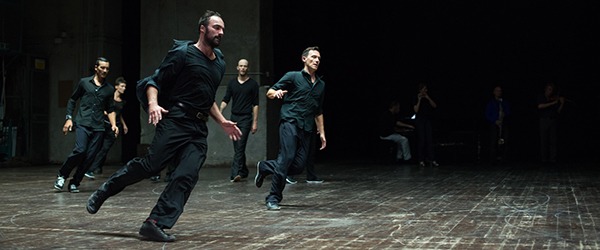
mage courtesy of Sydney Festival
Home | Blog | Welcome Back – 2016
Welcome Back – 2016
Welcome back.
It’s 2016 and the first event on the calendar is Sydney Festival. The events that left an indelible impression were strangely all about circles, temporal and spatial loops and repetitions.
My Festival experience began with a talk held by Belgian choreographer Anne Teresa de Keersmaeker. Her initial manner was short and I wasn’t envying the task ahead for Erin Brannigan as interviewer. De Keersmaeker had just finished her first program of the season Fase, a work she had first danced 30 years ago. I didn’t see it but general feedback was that the work was physically demanding. Of Fase, De Keersmaeker alluded to repetition and the intent to augment a simple phrase, a direct treatment in response to composer Steve Reich. She asked the audience, “What is it that children do?” Then, concluding that they spin, wave their arms and jump, implied this was a source of inspiration for her seminal durational work.
De Keersmaeker used the imagery of a spiral to introduce Vortex Temporum, her next work of the season with her company Rosas, this time talking about time. She referred to three modes of time specifically, those of whales, crickets and humans. I was and still am curious and more than a little confused. Maybe she was referring to speed. The speed of a cricket’s hum in relation to the seeming lumbering pace of a whale? Or the frequency of the sounds all three make?
What I do know is that Vortex Temporum occurred on a stage marked with overlapping and concentric circles. Dancers and musicians shared the stage equally and simultaneously and the choreography grew from a very static sequence into a virtual hurricane of movement in a counter -clockwise direction, gaining speed and momentum as it progressed. This was a work dancers could fall into and appreciate. The physical virtuosity was on display, to be admired from afar; we, as audience members, were spectators.
Second up for me was Nick Power’s Cypher. Where De Keersmaeker’s work was presented as though an object to be admired, with Power’s work we were in the thick of it, literally in amongst it. Whereas De Keersmaeker’s work clearly resembled the result of an intellectual pursuit, Power’s work opened as if it meant to propel us forward, with a lone dancer working his magic under a heart beating pulsing light. Cypher was a more immediate and visceral experience. The Cypher is the home of the street battle where hip hop dancer athletes perform and challenge. The merit of this work is that it lends this style a legitimacy on the high art festival arena while losing none of the intimacy of its origins.
Power’s dancers controlled the audience experience by a clever demarcation of stage space, with the introduction of packing holders loaded with gaffer tape. This began by creating smaller and smaller Cypher circles, forcing us to watch in closer and closer proximity, before proceeding to create several Cyphers at once, forcing us to choose our experience. I found myself just as entertained by the choice of navigation, being able to view one performance more readily while catching a glimpse of another masked by the energy and appreciation of those crowding around to watch it.
This was a slighter, shorter show, or maybe it just felt like it, as the dancers performed sequence after sequence of superhuman gymnastic feats. There was a section that encouraged audience participation to comment on each offering through several gestures, I later discovered, indicated a job well done, dodgy musicality and stealing or mimicry. I think this section has potential for more exploration.
My last event experience concerning the cyclical involved the Strong Women’s Tiwi Group from Bathurst and Melville Islands, off the coast of Darwin, in the Northern Territory. I think I became an overnight groupie as I followed them to three events, a children’s dance lesson in the park, a performance at the Museum of Contemporary Art and a collaborative event with jazz musicians in the Spiegeltent. The median age for this group was 70. Like Cypher, the first event was held in a circle. The dances were short and repetitive, the movement performed on the spot or around the perimeter of the circle. This was a participatory event. It was life affirming as we were guided through dances representing the animals of the dancers’ skin groups and our landscape. We channelled and attempted to embody crocodiles and their webbed feet, sharks and their dorsal fins cutting through the water, the horns of the buffalo, the head of the rainbow serpent and even the giddyup of a person in the saddle of a horse, the inclusion of the introduced species proving that Aboriginal dance in community is a living and evolving practice.
The jazz event felt a little like a workshop in progress, but the audience was appreciative and we had a collective goodwill that saw the tentative beginning, with the ladies keeping a protective distance from the mics, develop into a rousing performance. The ol’ girls even getting us up out of our chairs to rock to an instrumental number – traditional moves of another, more social kind, on display. I came away thinking to myself, I want to be dancing and living like that when I’m in my 70s.
As we farewell the successful contribution of Lieven Bertels as festival director this year my thoughts lead to anticipation of what the incoming director Wesley Enoch has in store.
– by Vicki Van Hout

